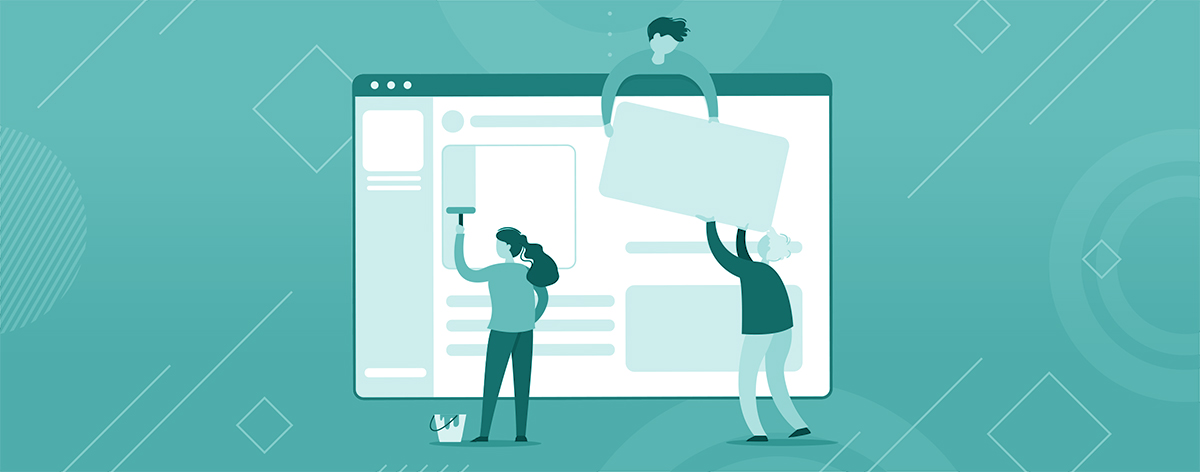Almost every brand has a website. And almost every digital (and even print) campaign that is boosting awareness or incentivizing an action is driving to that website. While getting traffic is a win, keeping viewers on the page and converting them is an entirely different game.
In today’s digital age, your website is often the first impression your brand will make on potential customers or partners. It’s where they’ll decide if it’s worth investing their money or time, and no one wants to invest in something that feels outdated or out of the loop. That’s why it’s more important than ever today to keep your website fresh and distinct—and be sure you’re making the right impression.
How often should you redesign your website?
While small updates here and there can help keep your content fresh, they can’t substitute for a full revamp. In our experience, every 2-3 years tends to be the sweet spot for a website redesign. Usually in that amount of time, new UX principles have emerged, consumer demand has shifted or your brand has undergone some of its own updates—all reasons to revisit your website experience and objectives.
Why is redesigning your website important?
Are you communicating the right messages? Are you leading your customers down the right path? Are you even connecting with them at all? Just like in person, making the right impression is important for the success of your business—online or off. A website redesign can help you stay relevant and make an impression that drives results.
First impressions are everything
Did you know it takes about 50 milliseconds* (that’s 0.05 seconds) for users to form an opinion about your website that determines whether they like your site or not? Whether they’ll stay or leave? There’s no time for an elevator speech online. Every word, design element and path has to work as hard as possible to ensure that your website makes it past those first few seconds and all the seconds after.
An outdated CMS can lead to technical issues
Whether you use a custom CMS or an open source CMS, technical issues like broken links or down servers can have a huge (read: negative) impact on your user experience—and bottom line. So while you may hear the words revamp and just think about the front-end of your website, you may need to dig a little deeper and freshen up your CMS too. Here are the three reasons to spruce up your website right now.
Maintain competitive advantage
Innovation and evolution are found in every industry. From fab shops to agriculture equipment to insurance solutions, every brand strives to create industry-leading solutions that consumers want. A website is no different. While other sites are getting updated and inspiring new trends, they’re creating a perception of what is modern and new and what isn’t. The last thing your brand wants to do is fall behind in market share because of a poor website.
We make decisions based on visual cues
We use visual cues all the time to know where to go and what to do. Think about a red stop sign or a green light or a yellow dotted line in the street. The color, images and layout of content can have an immediate impact on your decision to stay or go, especially for websites. As web design trends shift and change though, the use of older visual cues can be disorienting or challenging for a visitor. However, this is an easy solve for a brand—just update your websites visual cues to enhance the user’s experience.
Website trends are constantly evolving
Over the last few years, website trends have continued to shift toward more user-centric experiences. While the trends themselves may evolve or change in how to present content and information, the goal of user-centered design remains the same—to put the user first. Remember that your website shouldn’t just be for users (or geared toward them) but also be about those users.
When should you redesign a website?
If you’re not sure your website really needs a redesign quite yet, then ask yourself the below questions. If you answer ‘yes’ to any of them, you may want to start planning for a website revamp.
- Has your brand changed?
- Do your competitor sites look better than yours?
- Is your site old and outdated?
- Does your site take a while to load?
- Is the website experience lacking on desktop and mobile?
- Is your website still not responsive?
- Is it a headache to add new tools or make simple changes?
- Are sales or conversions declining?
- Is it a struggle to find information on your site?
Here are the 9 benefits of a website redesign
1. More cost effective in the long run
Rather than throw money at short-term or band-aid solutions, a full redesign allows you to get it right from the start. Take time to audit your current website and look for opportunities to improve the user experience and overall usability of your website. Doing so can increase conversions and revenue.
2. Cohesive brand identity
Very rarely is a website handled by one single person. And even if it is, it’s still pretty rare that every update over the months or years has stayed consistent with your brand’s identity. A website redesign gives you the opportunity to take a step back and ensure your brand is putting a cohesive foot forward.
3. Improves SEO and site performance
Just like revisiting your brand identity, website redesigns are a perfect time to optimize site performance with relevant keywords. Ensure your website’s content matches what users are searching for and what they can find when they arrive.
4. Refreshed content strategy
You’re enhancing user flows, improving content and optimizing the experience. But what about your content strategy? Think about your digital presence holistically and refresh your content strategy in tandem with your website to create a unified, cohesive and modern digital powerhouse.
5. Optimized site experience
When 88% of online consumers are less likely to return to a site after a bad experience, it should be a priority to keep your site technically sound. Operating with an older, outdated content management system can mean technical complications and management limitations that will affect SEO, UX and eventually conversion rate. But updating your CMS can improve site functionality, security vulnerabilities and overall website performance. As well as provide an opportunity to relook at browser compatibility and responsive designs.
6. Increased flexibility
Updating your CMS, especially switch to a custom system, can provide more control over your content. At the same time, you can implement new technologies and ensure your software is at peak efficiency for your business and your users.
7. Responsive for all screens
As mobile usage continues to prevail; brands must keep in mind all screen sizes during a revamp. Responsive web design allows for this flexibility and accessibility on all screen resolutions. This is beneficial for your brand because it’s creates a unified look and feel across mobile, tablet and desktop without needed unique websites. It also consolidates your analytics and is easier to manage—especially when it comes to ongoing optimizations.
8. Reduces site speeds
Google released a speed update in July 2018, indicating that mobile site speed is now a major ranking factor for mobile search results. That means an older website, running older programming frameworks will always perform slower than website running new technologies—and get dinged for it in search rankings.
9. Improves security
With cyber threats and hidden risk lurking everywhere in the digital web, it’s crucial for brands to ensure the security of their private data and that of their users’. That’s why this an important benefit to end on, from both a user and brand standpoint, when it comes to website redesigns.
Time to get your revamp on
Website redesigns can be an intimidating thing to think about, especially if it’s been a while since you’ve done one. But the benefits of revamping your site earlier than later can be truly impactful on your brand and consumers—and that’s worth it all.


